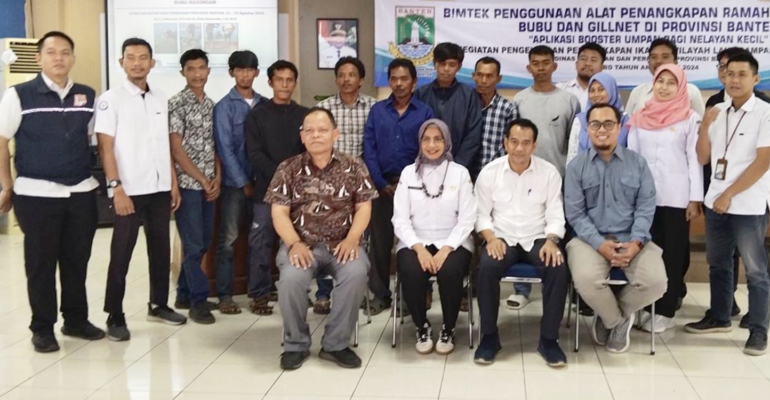IPB University Faculty’s Bait Booster Innovation Successfully Increases Catch Margins by Up to 236 Percent

Faculty members from IPB University have successfully implemented an innovative bait booster technology for fishermen in the waters of Banten Bay. This technology has proven to increase the profit margins of catches using rampus nets and crab traps by up to 236 percent.
The bait booster was invented by Dr Zulkarnain and Dr Didin Komarudin, both faculty members from the Department of Fisheries Resource Utilization (PSP) at the Faculty of Fisheries and Marine Science (FPIK), IPB University.
The increase in catch margins was demonstrated during trial results as part of a technical guidance program on the use of environmentally friendly fishing gear for crab trap and gillnet fishermen, as well as the application of the bait booster for small-scale fishermen.
This initiative, which is part of IPB University’s community service program, took place at the Hall of the Office of Marine and Fisheries (DKP) of Banten Province. The trials of the bait booster application during a one-day fishing trip were conducted in the waters of Banten Bay, involving fishermen from Lontar and Kubang Puji.
The event was attended and directly observed by the Chairperson of DKP Banten Province, Eli Susiyanti, SH, MH, MM; Chief of Capture Fisheries Division, Dr Sutirja Wijaya, SE, MM; Fishery Equipment Testing Analyst, Indra Supiyono Solihin, SPi; along with district fishery extension officers, and crab trap and gillnet fishermen.
In her opening remarks, the Chairperson of DKP Banten Province mentioned that fish catch production in the region has been declining, thus necessitating assistance in fishing gear for fishermen. She also emphasized the need for the application of technological innovations that can increase fish production.
Dr Zulkarnain explained that limited access to appropriate technology for small-scale fishermen can affect the productivity of the fishing gear they use and, in turn, reduce their income. The success of a capture fishery operation depends on several interrelated factors.
“The utilization of marine biological resources, particularly in capture fisheries, aims to achieve the maximum possible yield without compromising the sustainability of fish resources. To achieve this goal, certain requirements must be met in fishing technology, including effective and efficient fishing gear made from quality materials, improved vessels, appropriate fishing aids (appropriate technology), and reliable fishing operation methods,” he explained.
Dr Zulkarnain emphasized that appropriate technology can help achieve optimal catch yields, directly impacting fishermen’s income. This technology includes a bait booster designed to attract and concentrate fish, making them easier to catch with the fishing gear used by fishermen.
“The bait booster is an innovative tool designed to attract and concentrate fish effectively due to its content of animal protein with essential amino acids, which produces a scent that acts as a chemical stimulus. This stimulates the fish’s sense of smell and taste, making the bait highly appealing to them,” Dr Zulkarnain elaborated.
He further detailed that the bait booster is made from a combination of natural ingredients, including bycatch fish (‘tembang’/‘pepetek’/‘kapas-
The bait booster has undergone research trials with various fishing gears used by fishermen, such as floating rafts, hand lines, trammel nets, gillnets, trap nets, and mini purse seines, yielding significant results. According to Dr Zulkarnain, the increase in catch margins from using the bait booster compared to the control ranged from 50 to 170 percent, depending on the fishing season and specific gear used.
The bait booster application activities began with a demonstration of how to make frozen bait boosters (300 g/box), which was directly performed by fishermen and fishery extension officers. The fishing trials using gillnets involved 20 boxes of frozen bait boosters for 5 stretches, compared to 5 stretches without the bait booster (control).
“The fishing trials with a one-hour soak time resulted in a 236 percent increase in catch margins using the bait booster compared to the control,” he stated.
The catch using the bait booster consisted of species such as mackerel, scad, kuro, white shrimp, and swordfish, totaling 3,7 kg (77 percent). In contrast, the control gillnet catch consisted of kuro, mackerel, scad, and white pomfret, totaling 1,1 kg (23 percent).
Meanwhile, the crab trap fishing trials used 30 boxes of frozen bait boosters for 30 traps and were compared with 30 traps without the bait booster (control).
The fishing trials with a 12-hour soak time resulted in a 165 percent increase in catch margins using the bait booster compared to the control. The catch using the bait booster included 0,9 kg of crabs and 4 kg of tiger conchs (73 percent), while the control traps only caught 1,7 kg of tiger conchs (27 percent).
“The trial results have proven that the frozen bait booster is effective in attracting and concentrating fish, thereby increasing the catch from rampus nets and crab traps. Thus, small-scale capture fisheries require the innovative bait booster technology to increase catch yields and income for fishermen,” concluded Dr Zulkarnain. (*/Rz) (IAAS/RUM)



